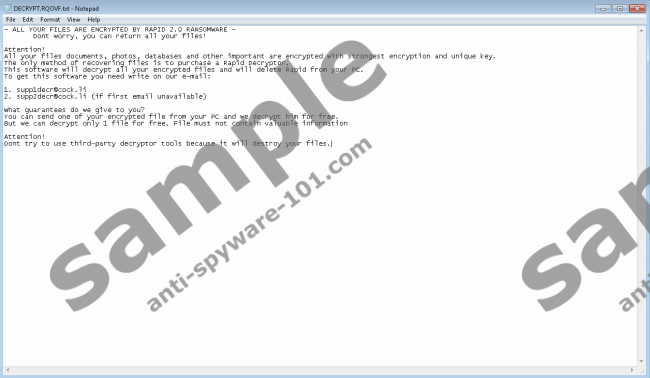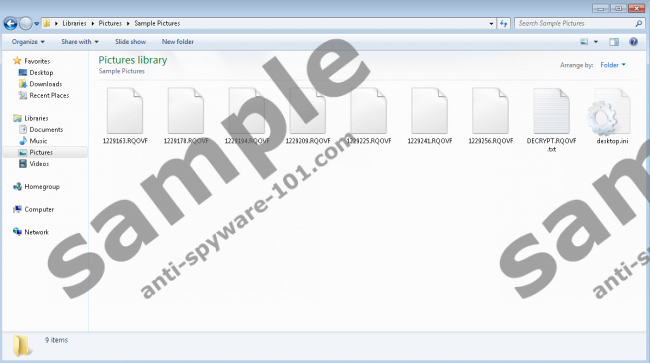What is Rapid 2.0 Ransomware?
Rapid 2.0 Ransomware is most likely a new version of our previously reviewed threat by a similar name (Rapid Ransomware). Our researchers at Anti-spyware-101.com were able to test it, and from what they have learned it seems this new variant is extremely dangerous. It is not enough that it may lock all user’s private files, but it might also continue encrypting new data even later on until it is removed from the computer. This is why we recommend erasing it with no hesitation the moment you notice it on your system. Paying the ransom as usual in such situations is not advisable since cybercriminals could trick you. To assist you with the malware’s deletion we will add steps explaining how to get rid of it manually just a bit below this article. However, if you need more help or have other questions about Rapid 2.0 Ransomware; feel free to write a comment at the end of this page or reach us via social media.

Where does Rapid 2.0 Ransomware come from?
There are a lot of ways to distribute threats like Rapid 2.0 Ransomware, but this time it seems cybercriminals choose to spread it via infected email attachments and unprotected Remote Desktop Protocol (RDP) connections. It means to guard the system against this malicious application it is essential to stay away from suspicious email attachments and make sure your computer does not have unprotected RDP connections as well as any other vulnerabilities, outdated software, and so on. If you do not have a legitimate antimalware tool yet, we would advise acquiring it as well as it could be useful in various situations. For example, you could scan suspicious email attachments or other questionable files with it, perform regular check-ups, etc.
How does Rapid 2.0 Ransomware work?
The malware seems to be able to run from the directory where its launcher was downloaded and does not need to create any Registry entries or other additional data. Stranger as it may sound the first thing it does is checking where you are from. Our researchers say the cybercriminals behind Rapid 2.0 Ransomware could be from Russia as they programmed the malware to spare victims from this particular country. Next, the infection should identify all personal files it can lock and then begin encrypting them. Unlike some other threats, instead of marking locked files with a specific second extension the malicious application should rename each file, and it looks like the new titles could be more or less random. Afterward, Rapid 2.0 Ransomware might place text documents containing ransom note in all paths where it encrypted data. According to them the user can unlock his files only with “Rapid Decryptor” and to obtain it they ought to write emails to supp1decr@cock.li or supp2decr@cock.li. It is not something we would encourage users to do as there is always a risk the cybercriminals could scam you, although they might sound reassuring.
How to erase Rapid 2.0 Ransomware?
It is important to understand, Rapid 2.0 Ransomware might keep encrypting all the new files you might create, download, or move from backup devices. Thus, it would be smart to clean the system before placing any new files. If you wish to deal with the malicious application manually, you should follow the instructions available below as they will tell you what to do. On the other hand, if you are not sure you can handle the task, you should leave it to a legitimate antimalware tool. Just pick a tool you prefer, perform a system scan, and then it should let you erase all detections with a single mouse click.
Eliminate Rapid 2.0 Ransomware
- Press Ctrl+Alt+Delete.
- Select Task Manager.
- Search for the malware’s process.
- Select this process and click End Task.
- Leave Task Manager.
- Tap Windows key+E.
- Navigate to the following paths:
%TEMP%
%USERPROFILE%\desktop
%USERPROFILE%\downloads - Find the file that infected the device.
- Right-click the malicious file and press Delete.
- Locate the malware’s ransom notes, right-click them one by one and press Delete.
- Close File Explorer.
- Empty your Recycle bin.
- Restart the system.
100% FREE spyware scan and
tested removal of Rapid 2.0 Ransomware*





0 Comments.